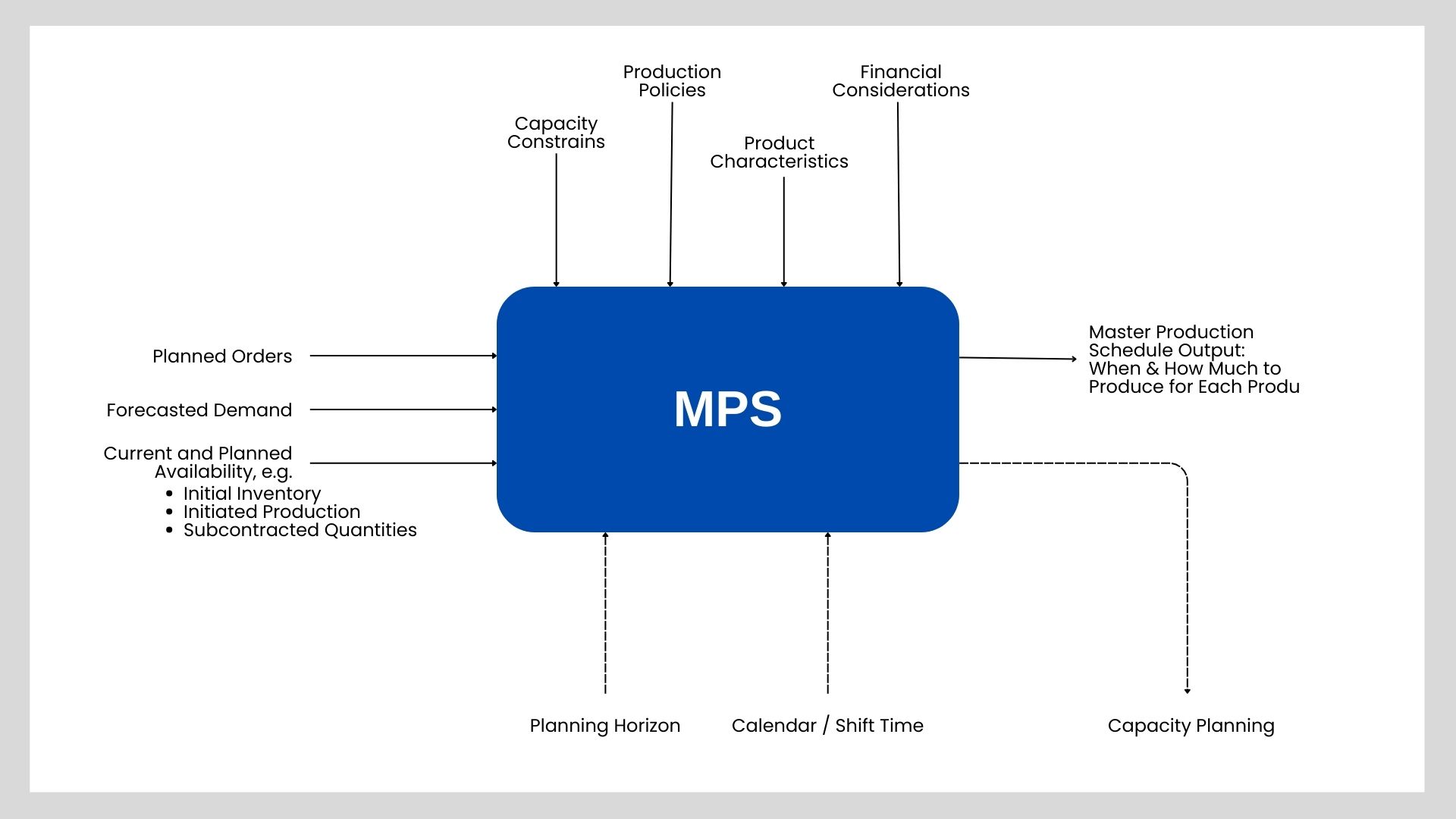List of contents:
- What is a Master Production Schedule (MPS)?
- Why is the Master Production Schedule (MPS) a Crucial Planning Function?
- What are the parts of the Master Production Schedule (MPS)?
- What are the Benefits of a Master Production Schedule (MPS)?
- What is the Relationship Between MPS and MRP?
- MPS is the core of a manufacturing ERP system
- What are the Common MPS Output Reports?
- How Does Master Production Schedule (MPS) Software Function?
- Odoo's role in the Master Production Schedule (MPS).

What is a Master Production Schedule (MPS)?
Master Production Schedule (MPS) is a document or planning system that determines what products will be produced, in what quantities, and when they must be produced. MPS is part of broader production planning and is critical in manufacturing systems to ensure that resources are available, customer demands are met, and production processes run efficiently.
MPS usually contains:
- Products to be produced
- Production quantity in a certain period
- Production schedule
- Information related to raw materials and production capacity
MPS serves as a guide for various departments, including production, inventory, and finance, to align their operations with larger business goals.
Why is the Master Production Schedule (MPS) a Crucial Planning Function?
MPS has an important role in production planning for several main reasons:
- Increasing Production Efficiency With clear planning, production can run in a more organized manner, avoiding bottlenecks and unnecessary delays.
- Optimizing Resource Usage By accurately determining raw material requirements and production capacity, MPS helps avoid material and labor waste.
- Improve Customer Satisfaction With production on schedule, customer orders can be fulfilled on time, increasing customer satisfaction and loyalty.
- Minimize Excess Stock or Stock Shortage MPS helps avoid excess stock which increases storage costs or stock shortages which hinder the production process.
- Supports Better Decision-Making With accurate and up-to-date data, managers can make more informed decisions regarding production, inventory, and distribution.
What are the parts of the Master Production Schedule (MPS)?
MPS consists of several main elements that function as components of production planning, including:
- Demand Forecast Predict customer demand based on historical data and market analysis.
- Inventory Data Stock information on raw materials and finished products available in the warehouse.
- Production Lead Time The time required to process a product from raw materials to finished products.
- Production Capacity Availability of labor, machines, and manufacturing facilities to meet production schedules.
- Production Schedule Production plan that includes the number of units and production date of each product.

What are the Benefits of a Master Production Schedule (MPS)?
Some of the key benefits of implementing MPS in manufacturing systems include:
- Increased operational efficiency. MPS helps increase production efficiency by setting optimal production schedules.
- Reduction of production and storage costs. With accurate planning, companies can avoid overproduction which causes high storage costs.
- Increase accuracy in inventory planning. With MPS, companies can know exactly the amount of raw materials and finished products needed in a certain period.
- Facilitate coordination between departments. MPS serves as a guide for various departments, such as production, purchasing, inventory, and finance, to align their plans.
- Increase flexibility in dealing with changes in market demand. With MPS, companies can adjust production based on changes in market demand.
What is the Relationship Between MPS and MRP?
Great stories have a personality. Consider telling a great story that provides personality. Writing a story with personality for potential clients will assist with making
MPS and Material Requirements Planning (MRP) have a close relationship in the manufacturing system:
- MPS focuses on final product production planning, determining what to produce and when.
- MRP works to ensure the availability of raw materials required for production according to the schedule specified in the MPS.
- MRP supports MPS by detailing raw material requirements and purchase order planning.
In other words, MPS is a high-level planning strategy, while MRP helps implement the strategy by managing raw material inventory.

MPS is the core of a manufacturing ERP system
In a manufacturing ERP (Enterprise Resource Planning) system, MPS acts as the core of production planning which connects various modules in ERP, such as:
- Inventory Module. Manage stocks of raw materials and finished goods, ensuring material availability under the planned production schedule.
- Production Module. Responsible for implementing production according to the schedule set by MPS, including monitoring production processes and resource efficiency.
- Finance Module. Assist in budgeting and planning production costs, including purchasing raw materials and operational expenses related to production.
- Sales and Customer Inquiry Module. Providing information about market demand and customer orders, so that MPS can prepare production schedules that are accurate and under customer needs.
Modern ERP systems enable MPS automation with real-time data, integration between various departments, and data-driven decision-making. With this approach, companies can ensure production runs smoothly, avoid delays, and improve overall operational efficiency.
What are the Common MPS Output Reports?
Some of the key reports generated from the MPS system include:
- Production Schedule – Displays the products to be produced along with the production schedule.
- Stock Demand and Availability Report - Ensuring the amount of stock is sufficient to meet demand.
- Production Capacity Report – Indicates whether production capacity is sufficient to meet the production schedule.
- Raw Material Estimate Report – Assist in planning material requirements.
- Production Performance Report – Measuring production efficiency based on the planned schedule.

How Does Master Production Schedule (MPS) Software Function?
MPS software helps companies in:
- Production Planning Automation – Reduce dependence on manual calculations.
- Real-Time Data Integration – Synchronize data between various departments.
- Optimization of Stock and Production Capacity – Avoid shortages or excesses of raw materials.
- Production Analysis and Prediction – Assists in strategic decision-making.
How Does Master Production Schedule (MPS) Software Function?
Odoo, as one of the leading ERP systems, has an MPS module that is integrated with various aspects of the manufacturing business. The following are some of the superior features of Odoo in supporting MPS:
- Automatic Production Schedule Creation Odoo allows production planning based on demand, available stock, and production capacity.
- Calculation of Raw Material Requirements (MRP) MPS in Odoo is integrated with MRP, ensuring raw materials are available on time for production.
- Production Capacity Management The system can adjust schedules based on available labor capacity and machines.
- Integration with Inventory and Purchasing Modules Ensure that the required raw materials can be ordered automatically if stock runs low.
- Real-Time Reporting and Analytics Odoo provides an interactive dashboard to monitor production performance, raw material availability, and operational efficiency.
- Flexibility in Production Adjustments If market demand changes, Odoo allows for quick adjustments to production schedules.
With these features, Odoo helps manufacturing companies manage production planning more efficiently, increase efficiency,y and optimize resources.

Conclusion
Master Production Schedule (MPS) is an important element in production planning that helps companies manage resources more effectively. MPS integration in ERP systems like Odoo enables automation, data-driven decision-making, and increased operational efficiency. By implementing an effective MPS, companies can increase productivity, reduce production costs, and provide better service to customers.